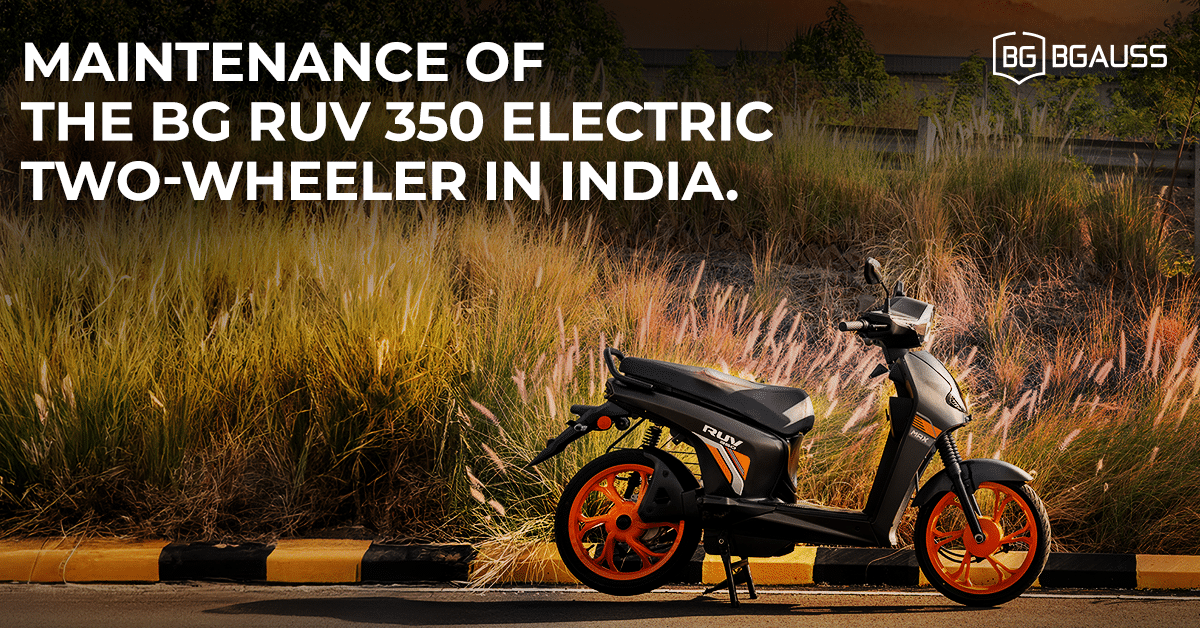
Maintenance of the BG RUV 350 Electric Two-Wheeler in India
Whenever we are sitting in a circle of friends and family, there’s always one person who takes suggestions if they should go for a particular model of vehicle as if they’re taking a survey to get a public view on their next vehicle. Nestled between answers like, wow nice choice, there’s always one answer saying, “Have you thought about the maintenance?”.
So, today we are here on this blog page to answer that question about the BG RUV 350 just for you.
India’s first RUV has redefined the electric mobility space with a bold new standard. The BG RUV 350 is not just an electric two-wheeler; it’s a powerful symbol of what happens when style, substance, and strength come together. Designed for Indian roads and Indian riders, the RUV 350 is India’s first electric two-wheeler to hold a national record for the only electric two-wheeler to reach the highest motorable road in the world, earning its rightful place in the Indian market.
But while the power-packed performance, striking design, and comfort features catch your eye—there’s one question that many prospective buyers and EV enthusiasts ask:
Is the maintenance of the BG RUV 350 electric two-wheeler high in India?
Let’s dive into the answer and see why the RUV 350 might just become your most cost-effective companion on the road.
Performance Meets Practicality
Before we talk about maintenance, it’s important to appreciate what the BG RUV 350 brings to the table. Built with an all-metal body, the vehicle delivers exceptional durability while maintaining a sleek and modern look. The 16-inch alloy wheels offer enhanced road grip and stability—especially important for Indian roads. With ample boot space, a smart TFT digital display, and an ergonomically designed seating posture, this scooter doesn’t just ride well—it rides smart.
Underneath that tough exterior is a Removable Lithium-ion Battery with IP67 protection, built to withstand water and dust. The AI-enabled Battery Management System (BMS) ensures the battery health and performance are optimized continuously. And all of this is available at an affordable price point that makes the RUV 350 a rare mix of affordability and ruggedness.
Petrol Scooter vs Electric Scooter: Maintenance Cost Comparison
To truly understand how maintenance costs stack up, let’s break down the average cost of maintaining a petrol scooter in India:
- Yearly servicing cost: ₹2,000
- Yearly part replacement (filters, spark plugs, engine oil, clutch cables, etc.): ₹4,000
- Total yearly maintenance: ₹6,000 (excluding fuel costs)
And this doesn’t even include the running cost, which, given today’s fuel prices, can average ₹2–3 per km for a petrol vehicle.
Now, here’s where the BG RUV 350 makes a significant difference.
Low Maintenance, High Durability: RUV 350’s Advantage
Electric vehicles are, by nature, more economical to maintain than petrol vehicles. The BG RUV 350 takes this further with:
1. Fewer Moving Parts
The RUV 350 uses an electric motor—which means no engine oil, no clutch, no carburetor, and no exhaust system. This drastically reduces the number of parts that can wear out over time. Fewer parts = fewer breakdowns and lower maintenance bills.
2. Battery and Motor Protection
The battery is protected with an IP67 rating, meaning it’s safeguarded from dust and water ingress. The motor, too, is built with precision engineering and IP67 rating to ensure long life. BGauss also includes remote diagnostics through its mobile app, allowing technicians to identify issues early without unnecessary trial and error.
3. Smart BMS for Battery Longevity
The AI-powered Battery Management System monitors the battery’s health, charge cycles, and performance in real time, which increases the lifespan of the battery and reduces the need for premature replacements.
4. Scheduled Service Intervals
Unlike petrol scooters that require servicing every 3–4 months, the RUV 350 can operate smoothly with bi-annual check-ups and occasional part replacements (like brake pads or tyres). On average, yearly maintenance cost can range between ₹1,500 to ₹2,000, depending on usage.
Charging Cost vs Fuel Cost
Another factor to consider in the total cost of ownership is the running cost:
- Fuel (Petrol scooter): ₹100 per litre, average mileage 40–50 kmpl = ₹2–₹2.5 per km
- Electricity (BG RUV 350): Full charge consumes ~3 units of electricity
- 3 units x ₹8/unit = ₹24
- One charge gives approx. 100 km range
- Running cost = ₹0.24 per km
That’s nearly 10x cheaper than a petrol scooter on a per-kilometre basis!
Warranty and Support
The BG RUV 350 comes with:
- Battery Warranty: Up to 5 years or 1 lakh km (whichever is earlier)
- Motor Warranty: Up to 3 years
- Roadside Assistance
- Remote Diagnostics and Over-the-Air (OTA) Updates via the BGauss app
This robust support system ensures that your vehicle is well taken care of, reducing long-term expenses and offering peace of mind.
Conclusion: Is It Expensive to Maintain the BG RUV 350?
Absolutely not. In fact, it’s quite the opposite.
When you compare it with a petrol scooter, the BG RUV 350 offers significantly lower maintenance costs, minimal part replacements, and negligible running costs. Add to that the advanced diagnostics, smart features, all-metal durability, and superior ride comfort, and you get a vehicle that’s not just strong on the outside but equally smart on the inside.
So if you’re looking for a powerful, stylish, and economical ride for Indian roads—one that’s tough like a bike and comfortable like a scooter—the BG RUV 350 is the electric two-wheeler you’ve been waiting for.
Visit www.bgauss.com to explore more and book a test ride today!
